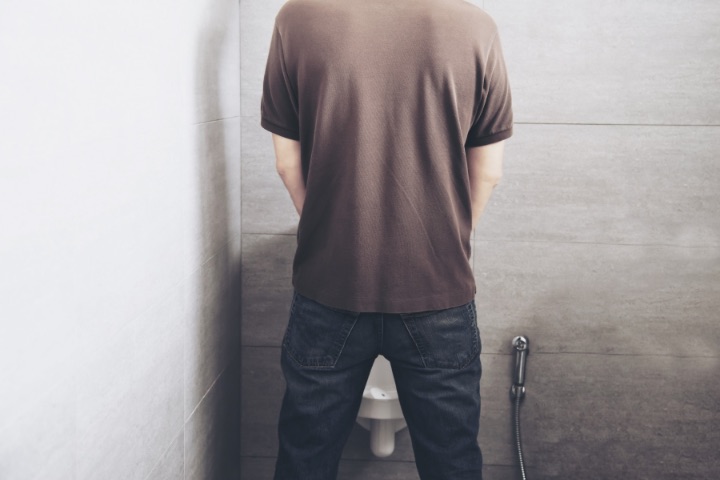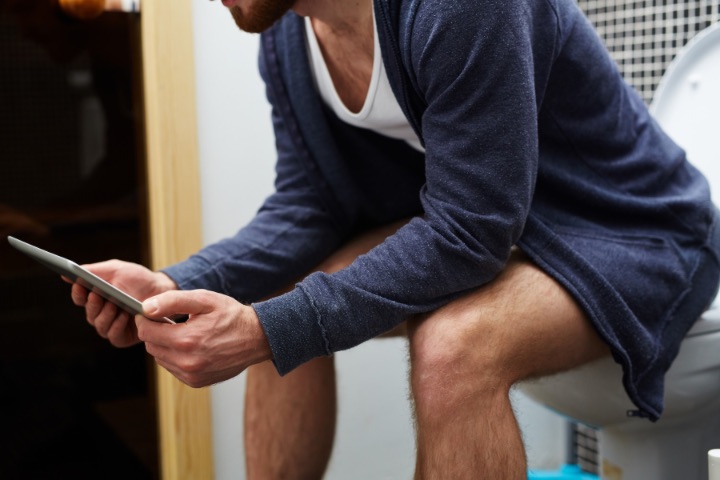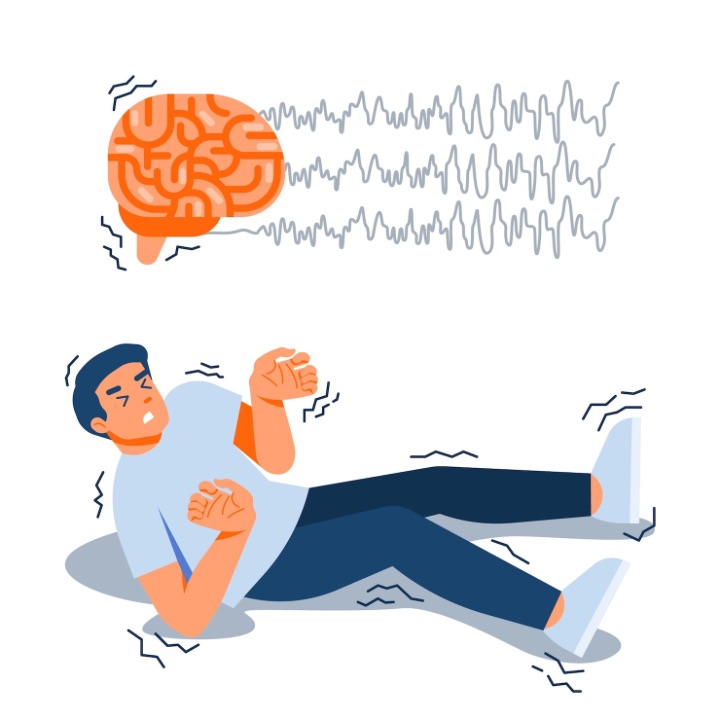Urinary incontinence in males, characterised by the involuntary loss of urine, can significantly impact a man’s quality of life. Though often associated with aging, it’s not a normal part of the process and can indicate underlying health issues such as prostate problems, neurological disorders, or bladder dysfunction.
This health issue manifests in several forms, including stress, urge, overflow, and total incontinence, each with unique symptoms and causes. While it might be an uncomfortable topic for many men, understanding urinary incontinence is the first step towards finding effective treatment and regaining control over one’s health.

Photo Credit: jcomp
Urinary incontinence affects men’s health differently depending on the type of incontinence they are experiencing. There are four main types of urinary incontinence, each with unique causes and symptoms.
Stress incontinence occurs when pressure is put on the bladder, causing urine to leak. This can happen when coughing, sneezing, laughing, or during physical activity like running or jumping. This type of incontinence is more common in men who have had prostate surgery or have weakened pelvic muscles as a result of aging.
Urge incontinence is also known as overactive bladder. This type of incontinence is characterised by a sudden and intense urge to urinate, followed by involuntary bladder contractions that cause urine to leak. Men with urge incontinence may need to urinate frequently, even during the night. Causes of this type of incontinence can include bladder infections, nerve damage, or an enlarged prostate.
Overflow incontinence occurs when the bladder doesn’t empty completely, causing it to become overly full and leak urine. This type of incontinence is more common in men with an enlarged prostate, bladder damage, or nerve damage that affects the bladder muscles.
Total incontinence is the most severe type of urinary incontinence in men. Men with total incontinence experience constant urine leakage and cannot control their bladder. This type of incontinence is rare and can be caused by a variety of factors, including bladder or urethral damage, nerve damage, or a birth defect.

Photo Credit: pressfoto
If you are experiencing any of the symptoms associated with urinary incontinence, it is important to speak with a healthcare professional. They can help you identify the type of incontinence you are experiencing and recommend the appropriate treatment to help manage your symptoms and improve your quality of life.
Urinary incontinence in men can be a distressing condition, affecting physical and emotional health. Understanding the common symptoms associated with urinary incontinence can help men seek appropriate medical care and treatment.
One of the primary symptoms of male incontinence is bladder leakage. This may occur during physical activities such as coughing, sneezing, or exercise. It may also happen during everyday activities, such as bending down or lifting something heavy. In more severe cases, urinary leakage may happen without any warning or control.
Other common symptoms of urinary incontinence in men include urine loss and frequent urination. Men with urinary incontinence may also experience a sudden, intense urge to urinate or struggle to empty their bladder fully. These symptoms can significantly impact daily life and activities.
It’s important to note that urinary incontinence is not a normal part of ageing and should not be ignored. Seeking medical advice and treatment can help manage symptoms and improve quality of life.
Urinary incontinence can be caused by a variety of factors, including prostate health, bladder disorders, and neurological conditions that affect the bladder muscles. Here are some of the most common causes:
The prostate gland plays a critical role in male urinary function. As men age, the prostate may enlarge, which can put pressure on the urethra and disrupt urine flow. Enlarged prostate, also known as benign prostatic hyperplasia (BPH), is a frequent cause of urinary incontinence in men. Other prostate issues, such as prostate cancer or prostate surgery, can also impact urinary function.
A variety of bladder disorders can cause urinary incontinence in men. These may include overactive bladder, underactive bladder, and bladder inflammation. Bladder infections, urinary tract infections, and bladder stones can also affect bladder function and lead to urinary incontinence in men.
Conditions that affect the nervous system can disrupt the signals between the bladder and the brain, leading to urinary incontinence. Neurological conditions contributing to male incontinence include Parkinson’s disease, spinal cord injuries, multiple sclerosis, and stroke.

Photo Credit: Freepik
Understanding the underlying cause of urinary incontinence is critical in developing an effective treatment plan. Consult with a medical professional to receive a proper diagnosis and explore appropriate treatment options.
When it comes to treating urinary incontinence in men, many options are available. The course of treatment will depend on the type and severity of the condition, as well as the individual’s medical history and overall health.
One of the first approaches to treating urinary incontinence is often medication. These medications work by relaxing the bladder or reducing the urge to urinate, depending on the type of incontinence being experienced. It’s important to consult with a doctor before starting any medication to ensure it’s safe and effective for the individual’s specific situation.
Another common approach to treating urinary incontinence in men is bladder training and pelvic floor exercises. This involves learning techniques to strengthen the muscles that control bladder function, as well as retraining the bladder to hold urine for longer periods of time.
One popular exercise for men with urinary incontinence is the Kegel exercise. This involves tightening and relaxing the pelvic floor muscles, which can help strengthen them over time. A doctor or physical therapist can provide guidance on the best techniques for pelvic floor exercises and bladder training.
In some cases, surgical intervention may be necessary to treat urinary incontinence in men. This may involve procedures such as prostate surgery or bladder reconstruction. Discussing the potential risks and benefits of any surgical approach with a doctor before undergoing the procedure is important.
When seeking treatment for urinary incontinence, it’s important to consult with a urologist specialising in the urinary tract and male reproductive system conditions. They can help provide a personalised treatment plan based on the individual’s unique situation and medical history.

Photo Credit: vector4stock
Overall, with a range of treatment options available, there is hope for men with urinary incontinence to improve their quality of life and regain control of their bladder function.
Living with urinary incontinence can be challenging, but there are many ways to manage the condition and improve your quality of life. Here are some tips and strategies to help you manage urinary incontinence:
Using incontinence pads or men’s incontinence underwear can provide extra protection against bladder leakage. These products are available in a range of styles and absorbency levels, so you can choose the option that best suits your needs.
In some cases, surgery may be recommended to address urinary incontinence. This may involve procedures like prostate surgery or the placement of a urinary sling. Your urologist can help you determine if surgery is viable for your situation.
Proper diagnosis and treatment are key to managing urinary incontinence. Be sure to consult with a urologist to develop a personalised treatment plan that addresses the underlying causes of your incontinence.
Exercises targeting the pelvic floor muscles can effectively improve bladder control. Kegel exercises for men, in particular, can help strengthen the muscles that support the bladder and urethra. Your urologist or a pelvic floor physiotherapist can guide these exercises.
Other strategies for managing urinary incontinence include avoiding bladder irritants like caffeine and alcohol, scheduling regular bathroom breaks, and practising good sphincter control. Your urologist can provide additional guidance on these and other management techniques.

Photo Credit: rawpixel
Remember, managing urinary incontinence is a process. With the right resources and support, you can take steps to improve your bladder control and live life on your own terms.
For many men, managing urinary incontinence involves changing their daily routines and lifestyles. Depending on the severity and type of incontinence, various strategies can help improve bladder control and reduce the likelihood of accidents or leakage.
In some cases, bladder dysfunction may be contributing to urinary incontinence. Addressing this issue may involve taking steps such as reducing caffeine and alcohol intake, avoiding certain foods and drinks that irritate the bladder, and engaging in timed voiding or scheduled bathroom trips to better train the bladder.
For men with overactive or underactive bladder, managing bladder leakage may involve various techniques such as performing bladder control exercises (also known as Kegel exercises), using absorbent products like incontinence pads or men’s incontinence underwear, and utilising bladder control aids like urinary catheters.
Strengthening the muscles that control the bladder sphincter can also help manage urinary incontinence. This can be achieved through pelvic floor exercises and bladder control exercises, improving overall bladder control and potentially reducing leakage.
Incontinence aids such as pads and underwear can effectively manage urinary incontinence, especially for those who may experience occasional leaks or accidents. A wide variety of products are available specifically for men, including incontinence pads and absorbent underwear designed to fit comfortably and discreetly.
For men with more severe cases of urinary incontinence, rehabilitation and physiotherapy may be recommended. This can involve working with a trained professional to develop a personalised treatment plan that involves exercises, techniques, and lifestyle changes designed to improve bladder control and reduce incontinence symptoms.
Various resources are available specifically for men with urinary incontinence, including support groups, forums, and educational materials. These resources can help provide information, advice, and emotional support for those dealing with incontinence challenges and can help men feel less alone as they navigate their condition.

Photo Credit: Freepik
Ultimately, managing urinary incontinence in men involves a multifaceted approach considering various factors such as lifestyle, bladder function, and overall health. Whether through bladder control exercises, lifestyle changes, or support and resources, men have many options for managing urinary incontinence and improving their overall quality of life.
Several factors can cause urinary incontinence in males. These include prostate problems such as an enlarged prostate or prostate cancer, neurological disorders like Parkinson’s disease or strokes, bladder disorders, urinary tract infections, and certain medications. Factors like aging, obesity, and long-term diabetes can also contribute to urinary incontinence.
The treatment of urinary incontinence in men can vary based on the underlying cause and type. Treatments can range from lifestyle changes like weight management and avoiding bladder irritants to pelvic floor exercises (Kegels), medications, bladder training, and in some cases, surgery. The use of absorbent pads and catheters may also be necessary.
The four types of incontinence in men are stress incontinence (urine leakage during activities that increase abdominal pressure like coughing or lifting), urge incontinence (a sudden, strong urge to urinate), overflow incontinence (constant or frequent leakage due to a bladder that doesn’t fully empty), and total incontinence (continuous leakage).
While urinary incontinence can occur in men, particularly with aging or certain medical conditions, it’s not considered “normal.” If a man is experiencing urine leakage, it’s important to discuss this with a healthcare provider, as it can be a symptom of an underlying condition that needs treatment.